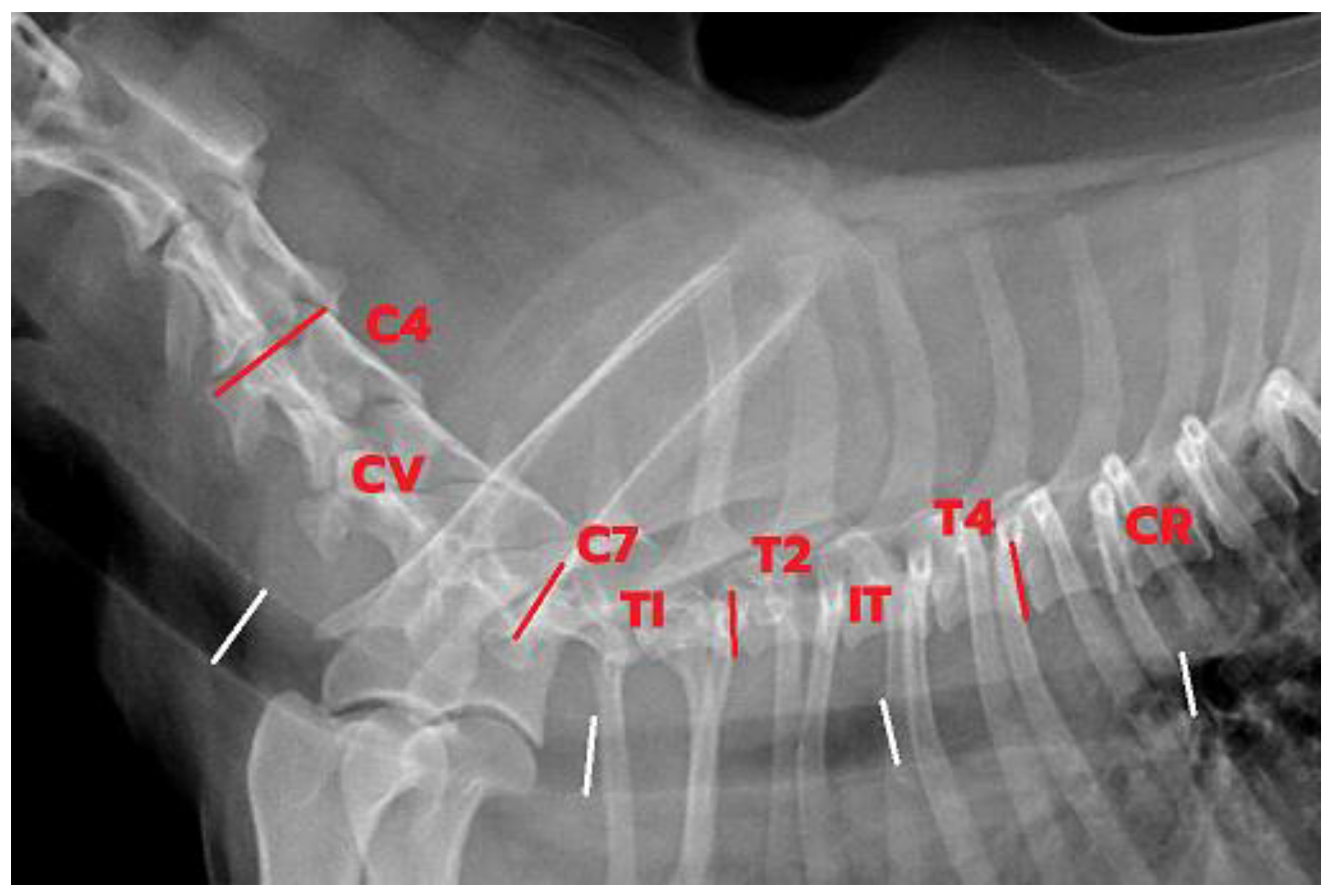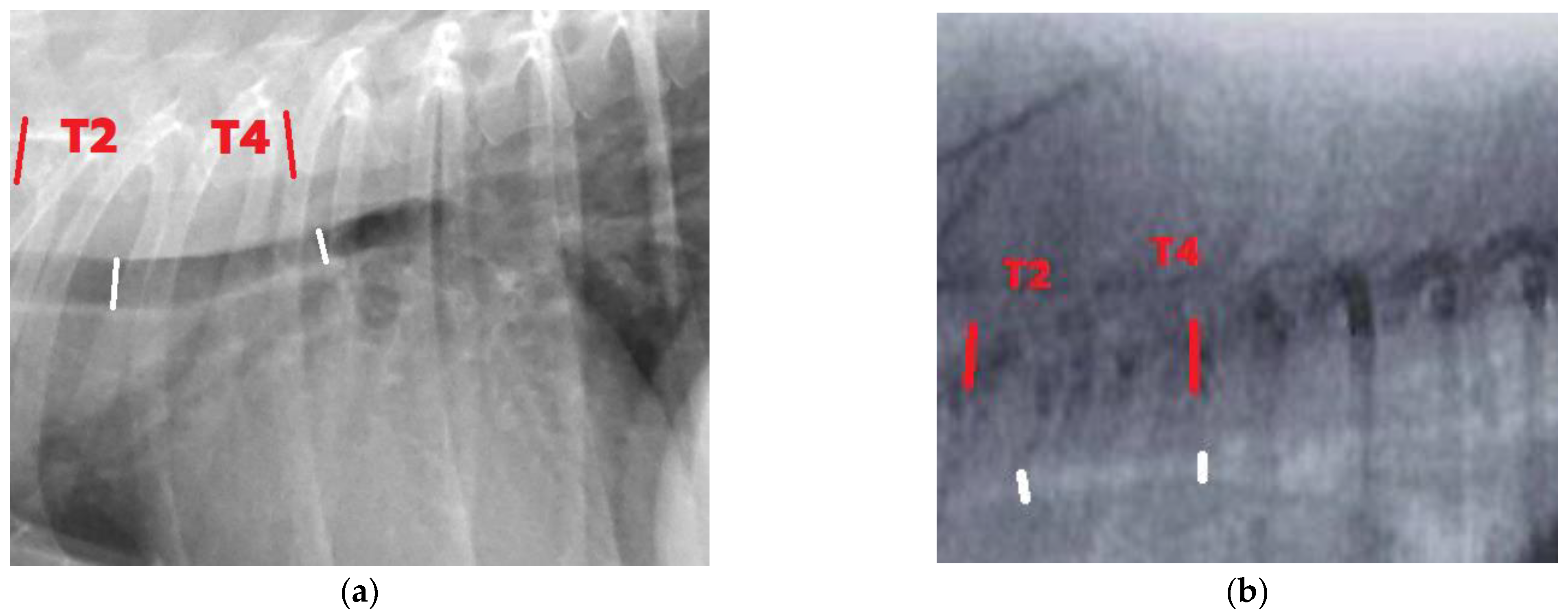The Agreement between Radiography and Fluoroscopy as Diagnostic Tools for Tracheal Collapse in Dogs
Abstract
Simple Summary
Abstract
1. Introduction
2. Materials and Methods
2.1. Dogs
2.2. Imaging Study
2.3. Statistical Analysis
3. Results
3.1. Demographic Characteristics and Clinical Outcomes
3.2. Imaging Results
4. Discussion
5. Conclusions
Supplementary Materials
Author Contributions
Funding
Institutional Review Board Statement
Informed Consent Statement
Data Availability Statement
Acknowledgments
Conflicts of Interest
References
- Tappin, S.W. Canine tracheal collapse. J. Small Anim. Pract. 2016, 57, 9–17. [Google Scholar] [CrossRef] [PubMed]
- Hedlund, C.S. Tracheal collapse. Probl. Vet. Med. 1991, 3, 229–238. [Google Scholar] [PubMed]
- Johnson, L.R.; Fales, W.H. Clinical and microbiologic findings in dogs with bronchoscopically diagnosed tracheal collapse: 37 cases (1990–1995). J. Am. Vet. Med. Assoc. 2001, 219, 1247–1250. [Google Scholar] [CrossRef] [PubMed]
- Johnson, L.R.; Singh, M.K.; Pollard, R.E. Agreement Among Radiographs, Fluoroscopy and Bronchoscopy in Documentation of Airway Collapse in Dogs. J. Vet. Intern. Med. 2015, 29, 1619–1626. [Google Scholar] [CrossRef] [PubMed]
- Heng, H.G.; Lim, C.K.; Gutierrez-Crespo, B.; Guptill, L.F. Radiographic and computed tomographic appearance of tracheal collapse with axial rotation in four dogs. J. Small Anim. Pract. 2018, 59, 53–58. [Google Scholar] [CrossRef] [PubMed]
- Eom, K.; Moon, K.; Seong, Y.; Oh, T.; Yi, S.; Lee, K.; Jang, K. Ultrasonographic evaluation of tracheal collapse in dogs. J. Vet. Sci. 2008, 9, 401–405. [Google Scholar] [CrossRef] [PubMed]
- Macready, D.M.; Johnson, L.R.; Pollard, R.E. Fluoroscopic and radiographic evaluation of tracheal collapse in dogs: 62 cases (2001-2006). J. Am. Vet. Med. Assoc. 2007, 230, 1870–1876. [Google Scholar] [CrossRef] [PubMed]
- Altman, K.W.; Wetmore, R.F.; Mahboubi, S. Comparison of endoscopy and radiographic fluoroscopy in the evaluation of pediatric congenital airway abnormalities. Int. J. Pediatr. Otorhinolaryngol. 1998, 44, 43–46. [Google Scholar] [CrossRef] [PubMed]
- Wang, T.; Xu, Q.; Dai, G.; Hong, Y.; Chen, Z.; Lu, M.; Yan, Y.; Jiang, W. Clinical characteristics of children with airway malacia complicated by pneumonia. BMC Infect. Dis. 2021, 21, 902. [Google Scholar] [CrossRef] [PubMed]
- Berg, E.; Naseri, I.; Sobol, S.E. The role of airway fluoroscopy in the evaluation of children with stridor. Arch. Otolaryngol. Head. Neck Surg. 2008, 134, 415–418. [Google Scholar] [CrossRef] [PubMed]
- Portier, K.; Ida, K.K. The ASA Physical Status Classification: What Is the Evidence for Recommending Its Use in Veterinary Anesthesia?—A Systematic Review. Front. Vet. Sci. 2018, 5, 204. [Google Scholar] [CrossRef] [PubMed]
- Reinero, C.R.; Masseau, I. Lower airway collapse: Revisiting the definition and clinicopathologic features of canine bronchomalacia. Vet. J. 2021, 273, 105682. [Google Scholar] [CrossRef] [PubMed]
- Tangner, C.H.; Hobson, H.P. A Retrospective Study of 20 Surgically Managed Cases of Collapsed Trachea. Vet. Surg. 1982, 11, 146–149. [Google Scholar] [CrossRef]
- Scherf, G.; Masseau, I.; Bua, A.-S.; Beauchamp, G.; Dunn, M.E. Fluoroscopic and radiographic assessment of variations in tracheal height during inspiration and expiration in healthy adult small-breed dogs. Can. J. Vet. Res. 2020, 84, 24–32. [Google Scholar] [PubMed]
- Jeung, S.-Y.; Sohn, S.-J.; An, J.-H.; Chae, H.-K.; Li, Q.; Choi, M.; Yoon, J.; Song, W.-J.; Youn, H.-Y. A retrospective study of theophylline-based therapy with tracheal collapse in small-breed dogs: 47 cases (2013–2017). J. Vet. Sci. 2019, 20, e57. [Google Scholar] [CrossRef] [PubMed]
- McHugh, M.L. Interrater reliability: The kappa statistic. Biochem. Med. 2012, 22, 276–282. [Google Scholar] [CrossRef]
- Fagerland, M.W.; Lydersen, S.; Laake, P. The McNemar test for binary matched-pairs data: Mid-p and asymptotic are better than exact conditional. BMC Med. Res. Methodol. 2013, 13, 91. [Google Scholar] [CrossRef] [PubMed]


| Region | Fluoroscopy (%) | Radiography (%) | p-Value | |
|---|---|---|---|---|
| Overall | Cervical | 8.04 (4.32–14.02) | 9.29 (3.29–15.04) | 0.780 |
| Thoracic | 12.35 (8.43–17.97) | 11.33 (4.2–20.4) | 0.537 | |
| Intra thoracic | 12.46 (8.86–20.13) | 12.20 (6.73–17.6) | 0.213 | |
| Carina | 18.75 (14.12–27.31) | 11.59 (4.76–20.15) | <0.001 | |
| Day 0 | Cervical | 11.11 (5.40–21.28) | 10.06 (3.8–13.06) | 0.243 |
| Thoracic | 15.52 (10.00–20.20) | 14.79 (7.02–21.83) | 0.905 | |
| Intra thoracic | 15.00 (10.94–21.74) | 12.84 (6.43–17.44) | 0.090 | |
| Carina | 20.38 (14.31–27.92) | 13.86 (6.51–22.28) | 0.037 | |
| Day 14 | Cervical | 8.04 (4.12–13.09) | 6.54 (2.08–15.99) | 0.974 |
| Thoracic | 9.97 (7.37–17.21) | 10 (3.925–18.42) | 0.627 | |
| Intra thoracic | 13.24 (6.95–19.62) | 15.32 (10.43–20.35) | 0.347 | |
| Carina | 20.10 (13.74–27.90) | 11.22 (4.44–17.15) | 0.010 | |
| Day 56 | Cervical | 7.17 (3.65–12.09) | 10.39 (3.66–15.37) | 0.150 |
| Thoracic | 10.39 (8.54–16.60) | 9.93 (2.88–21.00) | 0.611 | |
| Intra thoracic | 11.89 (7.97–19.76) | 8.49 (5.04–13.36) | 0.150 | |
| Carina | 17.01 (13.47–24.16) | 11.46 (4.08–18.85) | 0.002 |
| Regions | Agreement (%) | Both Present | Both Absent | Flu+/Rad− | Flu−/Rad+ | p Value of McNemar’s Test | Kappa | Odds Ratio (CI) |
|---|---|---|---|---|---|---|---|---|
| Cervical | 65/87 (74.72) | 6/87 | 59/87 | 11/87 | 11/87 | 1.000 * | 0.20 | 1.0 (0.39–2.54) |
| Thoracic inlet | 48/87 (55.17) | 10/87 | 38/87 | 17/87 | 22/87 | 0.522 | 0.00 | 1.3 (0.66–2.60) |
| Intra thoracic | 41/87 (47.13) | 7/87 | 34/87 | 28/87 | 18/87 | 0.184 | −0.15 | 0.6 (0.34–1.20) |
| Carina | 40/87 (45.98) | 19/87 | 21/87 | 35/87 | 12/87 | 0.001 | −0.01 | 0.3 (0.16–0.68) |
Disclaimer/Publisher’s Note: The statements, opinions and data contained in all publications are solely those of the individual author(s) and contributor(s) and not of MDPI and/or the editor(s). MDPI and/or the editor(s) disclaim responsibility for any injury to people or property resulting from any ideas, methods, instructions or products referred to in the content. |
© 2023 by the authors. Licensee MDPI, Basel, Switzerland. This article is an open access article distributed under the terms and conditions of the Creative Commons Attribution (CC BY) license (https://creativecommons.org/licenses/by/4.0/).
Share and Cite
Yangwanitset, W.; Huaijantug, S.; Tansakul, M.; Sakcamduang, W. The Agreement between Radiography and Fluoroscopy as Diagnostic Tools for Tracheal Collapse in Dogs. Animals 2023, 13, 1434. https://doi.org/10.3390/ani13091434
Yangwanitset W, Huaijantug S, Tansakul M, Sakcamduang W. The Agreement between Radiography and Fluoroscopy as Diagnostic Tools for Tracheal Collapse in Dogs. Animals. 2023; 13(9):1434. https://doi.org/10.3390/ani13091434
Chicago/Turabian StyleYangwanitset, Wasutorn, Somkiat Huaijantug, Mookmanee Tansakul, and Walasinee Sakcamduang. 2023. "The Agreement between Radiography and Fluoroscopy as Diagnostic Tools for Tracheal Collapse in Dogs" Animals 13, no. 9: 1434. https://doi.org/10.3390/ani13091434
APA StyleYangwanitset, W., Huaijantug, S., Tansakul, M., & Sakcamduang, W. (2023). The Agreement between Radiography and Fluoroscopy as Diagnostic Tools for Tracheal Collapse in Dogs. Animals, 13(9), 1434. https://doi.org/10.3390/ani13091434





